Local Memo: Google Describes “Self-Updating” Maps

In this week’s update, learn about Google’s self-updating Maps technology; product listings as a ranking factor; showcased offer posts in business profiles; Google’s new multisearch feature; newly prominent recycling attributes; and TikTok’s colossal growth.
Google Describes “Self-Updating” Maps
In a new blog post, Google describes how it uses a combination of technologies, including AI, to update Google Maps details, including hours of operation for businesses. Noting that the pandemic has created a fast changing environment where map details may quickly become out of date, the post explains that hours may be updated according to multiple factors, including how long it has been since the business updated its GBP profile, as well as signals from Google’s Popular Times feature that indicate customers are visiting a store even though its hours may list it as closed. Google also claims to use AI to predict the hours of a given store based on similar stores in its vicinity, and to check Street View imagery for visible storefront signs indicating business hours. Signals from Local Guides and other Google users are also added to the mix, and in some countries, including the U.S., Google attempts to confirm hours with the business using its AI-powered Duplex virtual phone assistant. The company says they are targeting hours updates for 20 million businesses in the next 6 months. Google's use of virtual assistants shows the benefits of quick outreach to millions of businesses. The blog post continues with an account of Google’s effort to correct speed limit information with the use of third-party photo providers, who it says will eventually contribute more information to Maps such as the location of potholes and school zones.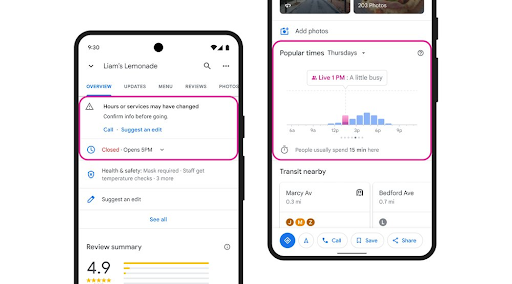
Using signals like Popular Times, Google signals to users that a business’s hours may have changed; image courtesy Google
Google Adds Product Callouts to GBP Help Documentation
I was able to break the news that Google has added some new information to its help document entitled “How to improve your local ranking on Google.” The document contains suggestions from Google on the features business owners should utilize in Google Business Profile in order to improve their rankings in local searches, with headings like “Enter complete data,” “Verify your locations,” “Keep your hours accurate,” “Manage & respond to reviews,” and “Add photos.” Now, Google has updated the list of suggestions to include “Add in-store products.” The text simply reads, “If you run a retail business, you can show nearby shoppers what you sell by adding your in-store products to your Business Profile.” The new section contains a link that guides small businesses in setting up Pointy to publish product inventory to their business profiles; the document notes this can also be done manually. Multi-location brands can upload store level inventory directly in the Merchant Center. In a post covering the news, Mike Blumenthal notes that Google has recently expanded the breadth of local search results containing product listings.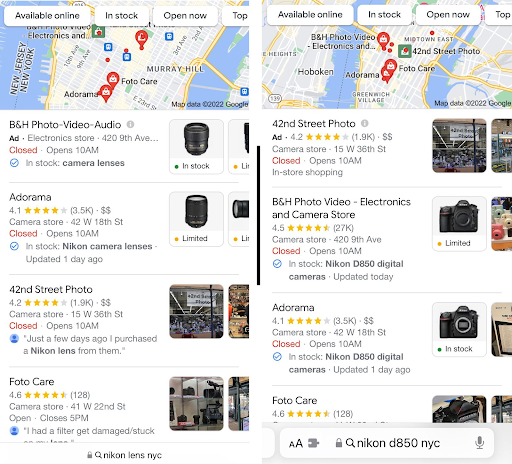
Product searches that previously did not return a Local Pack but now do, courtesy Mike Blumenthal
Prominent Google Offer Posts Carousel
SOCi’s eagle-eyed Michael Snow has spotted a new prominent placement for offer-type Google Posts in the Local Finder and in mobile business profiles. In the Local Finder, offers appear in a stacked display if the business profile features more than one offer post. On mobile, a similarly prominent display showcases the posts in a carousel format. This is more search real estate than Google Posts are typically granted, perhaps increasing the value of offer posts compared to other types. I can’t reproduce this new display yet but others have been able to.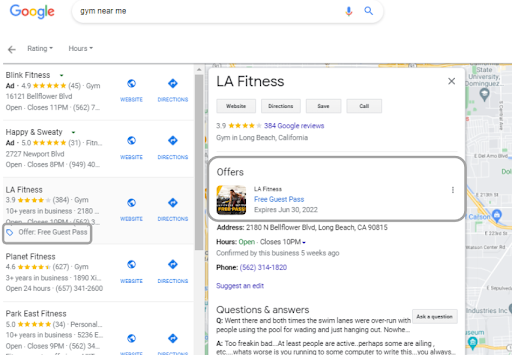
Prominent offer post in Local Finder version of business profile
Google Multisearch Lets Users Search by Images Plus Text
Previewed at an event last year, multisearch is now seeing an official launch from Google. The new search functionality allows users to initiate a search using an image and to add a text qualifier to the image before searching. Multisearch will now be available as an option in Google Lens. When searching for information about an image, users will now be able to ask specific questions or request specific kinds of information. Google’s examples include:- An image of an orange dress plus the word “green,” seeking the same dress in a different color
- An image of a dining table plus the phrase “coffee table,” looking for a matching piece of furniture
- An image of a rosemary plant plus the phrase “care instructions”
Google Adds Prominent Recycling Attributes
Last year, Google launched recycling attributes in business profiles, allowing business owners in select categories to specify which items they accept for recycling at in-store kiosks and drop-off stations. Now Google is calling out these attributes more prominently with an icon and a featured display in the business profile, whereas before users had to navigate to a list of attributes not visible on the main profile page. Prominent placement of certain attributes has been a trend in Google profiles since the early days of the pandemic, when Google added attributes like “Pickup” and “Delivery” to indicate availability of important services. Over time, more attributes were added to the list, some accompanied by custom icons. Some prominent attributes help businesses rank more highly in searches where the attribute is part of the query – for instance, a search for “Black-owned catering companies in Houston” returns a Local Pack with results displaying that attribute. It will be interesting to see if recycling attributes end up producing the same result.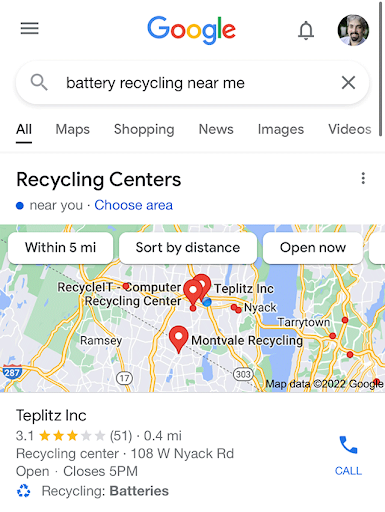
Image courtesy Barry Schwartz / Search Engine Roundtable
TikTok Remains the #1 App Worldwide
Despite intensified competition from Meta, TikTok has held onto its reign as the most downloaded app in the world, according to Q1 2022 results from Sensor Tower. TikTok’s download numbers continue to grow while Facebook is losing users; Instagram stopped reporting its user counts several years ago. Equally indicative of TikTok’s growing significance is its appearance at the top of the list of apps by revenue. Though 60% of TikTok’s revenue comes from its Chinese sister app Douyin, the company still achieved 125% U.S. revenue growth and had the highest in-app sales numbers in its history in Q1 at $840 million. Research firms data.ai and App Annie both predict that TikTok will surpass Instagram in monthly active users some time this year, and TikTok’s growth spike suggests the app may already have done so. This achievement would make TikTok second only to Facebook in worldwide adoption.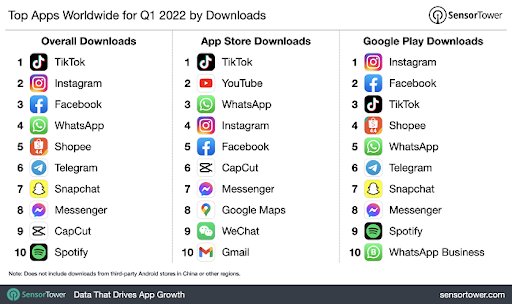
Courtesy Social Media Today
Subscribe to Local Memo!
Signup to receive Local memo updates and the latest on localized marketing, delivered weekly to your inbox.




